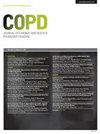Association Between the Serum Phosphate Levels and Hospital Mortality as Well as 90-Day Mortality Among Critically Ill Patients with Chronic Obstructive Pulmonary Disease: A Retrospective Cohort Study
IF 3.1
3区 医学
Q1 Medicine
International Journal of Chronic Obstructive Pulmonary Disease
Pub Date : 2024-07-18
DOI:10.2147/copd.s465752
引用次数: 0
Abstract
Purpose: COPD patients frequently have abnormal serum phosphorus levels. The objective of this study was to examine the correlation between serum phosphorus levels with hospital and 90-day mortality in critically ill patients with COPD.Patients and Methods: The MIMIC IV database was used for this retrospective cohort analysis. We extracted demographics, vital signs, laboratory tests, comorbidity, antibiotic usage, ventilation and scoring systems within the first 24 hours of ICU admission. Restricted cubic splines and multivariate cox regression analysis models were used to evaluate the connection between serum phosphorus with hospital and 90-day mortality. We assessed and classified various factors including gender, age, renal disease, severe liver disease, the utilization of antibiotics and congestive heart failure.
Results: We included a total of 3611 patients with COPD, with a median age of 70.7 years. After adjusting for all other factors, we observed a significant positive association between serum phosphate levels with both hospital mortality (HR 1.19, 95% CI: 1.07– 1.31, p< 0.001) and 90-day mortality (HR 1.15, 95% CI: 1.06– 1.24, p< 0.001). Compared to the medium group (Q2 ≥ 3.15, < 4.0), the adjusted hazard ratios for hospital mortality were 1.47 (95% CI: 1.08– 2, p=0.013), and 1.31 (95% CI: 1.06– 1.61, p=0.013) for 90-day mortality in the high group (Q3≥ 4.0). Hospital mortality decreased at serum phosphate levels below 3.8 mg/dl (HR 0.664, 95% CI: 0.468– 0.943, p=0.022), but increased for both hospital (HR 1.312, 95% CI: 1.141– 1.509, p< 0.001) and 90-day mortality (HR 1.236, 95% CI: 1.102– 1.386, p< 0.001) when levels were above 3.8 mg/dl. Subgroup and sensitivity analyses yielded consistent results.
Conclusion: In critical ill COPD patients, this study demonstrated a non-linear association between serum phosphate levels and both hospital and 90-day mortality. Notably, there was an inflection point at 3.8 mg/dl, indicating a significant shift in outcomes. Future prospective research is necessary to validate this correlation.
Keywords: COPD, serum phosphate, mortality, MIMIC-IV, critically ill
慢性阻塞性肺病重症患者血清磷酸盐水平与住院死亡率和 90 天死亡率之间的关系:一项回顾性队列研究
目的:慢性阻塞性肺病患者的血清磷水平经常异常。本研究旨在探讨 COPD 重症患者血清磷水平与住院及 90 天死亡率之间的相关性:这项回顾性队列分析使用了 MIMIC IV 数据库。我们提取了患者的人口统计学特征、生命体征、实验室检查、合并症、抗生素使用情况、通气情况以及入住重症监护室后 24 小时内的评分系统。我们使用限制性三次样条和多变量考克斯回归分析模型来评估血清磷与住院和 90 天死亡率之间的关系。我们对各种因素进行了评估和分类,包括性别、年龄、肾病、严重肝病、使用抗生素和充血性心力衰竭:我们共纳入了 3611 名慢性阻塞性肺病患者,中位年龄为 70.7 岁。在对所有其他因素进行调整后,我们观察到血清磷酸盐水平与住院死亡率(HR 1.19,95% CI:1.07- 1.31,p< 0.001)和 90 天死亡率(HR 1.15,95% CI:1.06- 1.24,p< 0.001)呈显著正相关。与中等组(Q2≥3.15,< 4.0)相比,高组(Q3≥4.0)的住院死亡率调整危险比为1.47(95% CI:1.08- 2,p=0.013),90天死亡率调整危险比为1.31(95% CI:1.06- 1.61,p=0.013)。当血清磷酸盐水平低于 3.8 mg/dl 时,住院死亡率下降(HR 0.664,95% CI:0.468- 0.943,p=0.022),但当血清磷酸盐水平高于 3.8 mg/dl 时,住院死亡率(HR 1.312,95% CI:1.141- 1.509,p< 0.001)和 90 天死亡率(HR 1.236,95% CI:1.102- 1.386,p< 0.001)均上升。分组分析和敏感性分析结果一致:本研究表明,在慢性阻塞性肺病重症患者中,血清磷酸盐水平与住院和 90 天死亡率之间存在非线性关系。值得注意的是,在 3.8 mg/dl 时出现了一个拐点,表明结果发生了显著变化。未来的前瞻性研究有必要验证这种相关性:慢性阻塞性肺病、血清磷酸盐、死亡率、MIMIC-IV、重症患者
本文章由计算机程序翻译,如有差异,请以英文原文为准。
求助全文
约1分钟内获得全文
求助全文
来源期刊

International Journal of Chronic Obstructive Pulmonary Disease
RESPIRATORY SYSTEM-
CiteScore
5.10
自引率
10.70%
发文量
372
审稿时长
16 weeks
期刊介绍:
An international, peer-reviewed journal of therapeutics and pharmacology focusing on concise rapid reporting of clinical studies and reviews in COPD. Special focus will be given to the pathophysiological processes underlying the disease, intervention programs, patient focused education, and self management protocols. This journal is directed at specialists and healthcare professionals
 求助内容:
求助内容: 应助结果提醒方式:
应助结果提醒方式:


